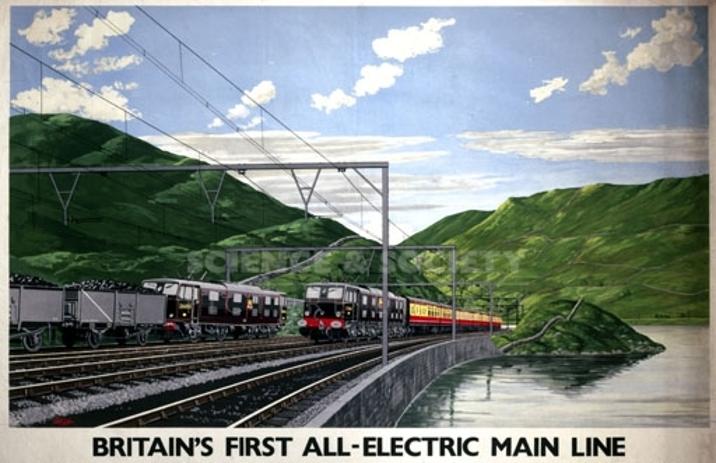
The poster that says it all; the UK's first all electric main-line.
This (in its original state) is said to be the most sought after poster of the route and can fetch good money.
Below is a three minute montage of the Woodhead route and its branch lines.
The Great Central Line from Lincoln to Sheffield passed through Woodburn Junction and onto The Sheffield Midland Station. It also split at Woodburn and went through to The Sheffield Victoria Station (see Victoria Station section), where it joined the iconic 'Woodhead line' which eventually traversed through the famous but controversial Woodhead tunnel and onto Manchester Victoria Station.
The Woodhead line between Woodhouse Jn and Manchester was the very first line in the UK to be electrified by overheads in 1954 at just 1500 volts DC.
However, the electrification scheme was to become a big costly mistake by British Rail.
They opted for the 1500v DC supply, but because the upgrade would take a staggering 18 years from planning to completion, the system was fast becoming outdated as the preferred system would turn out to be the 25Kv system as used today.
With this becoming a big embarrassment to BR they planned to upgrade the line to 25Kv, but this proved to be very costly with the estimate standing at £44 million…….
Unfortunately this doomed the line and paved the way for its closure just a mere 27 years after the initial electrification.
There was public uproar that the line would close after so much had been spent on the line.
Not only was the line electrified, but a THIRD Woodhead tunnel costing £4.25 million would be built for the overheads to fit.
The cost of the tunnel was more than the whole electrification scheme.
At the time the tunnel was the longest in the country at 3 miles and 22 yards, now its one of the longest disused tunnels.
Sir Nigel Gresley the designer of the ‘Flying Scotsman’ and the World speed record holder ‘Mallard’ both built in Doncaster was the designer of the locomotives in 1936 for the Woodhead electrification, but wouldn’t be used until after WW2.
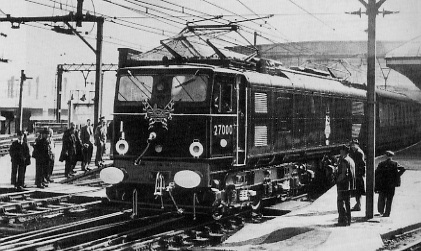
This is the official opening of the Woodhead route on the 14th of September 1954 with 27000 'Electra' the star of the show!

This is 'Electra' pictured at the Midland Railway Society at Butterley fully preserved. This Loco and the others like her were sold to the Netherland Railways (NR) after the Woodhead Route was closed. Electra was renumbered 1502 by 'NR' railways, and was returned to the UK on the 16th of July 1986 after clocking up almost 5 million miles. She only acheived 800,000 miles on the Woodhead line her 'home' route.
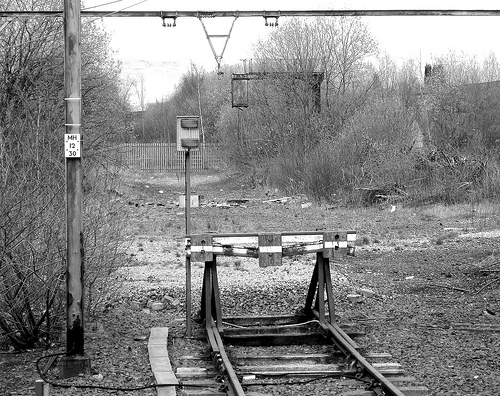
The end of the line at Hadfield Station.

The tracks are lifted and the overhead lines at Woodhead are gone.
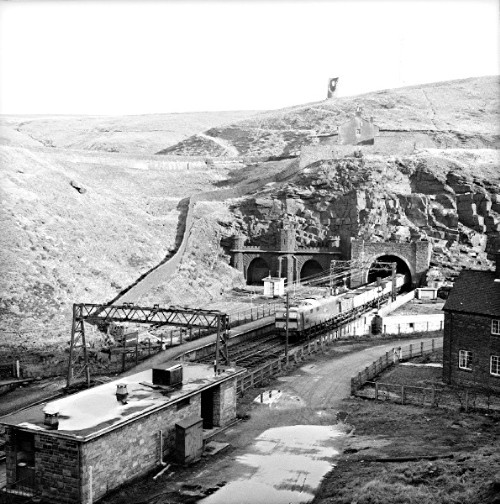
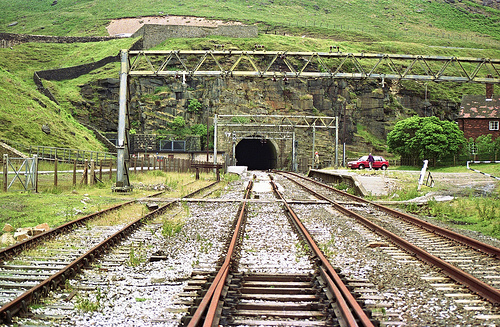
The tunnel above this picture in full use with the disused Victorian single line tunnels abandoned and above; shortly after closure the line is lifted.
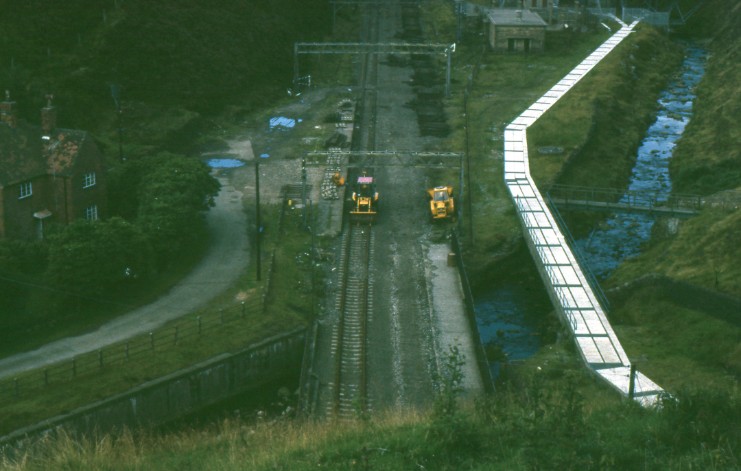
August 1986 and the track lifting is sadly underway at Woodhead Station. Ironic really that track lifting began just after 'Electra' (see above) was returned to the UK.
Picture courtesy of Dave Stones.
The same view in August 2010 and sadly the National Grid work is underway.
The above and below pictures are of a recent walk in August 2010; the picture above still shows an electrification base on the trans-pennine walk from Woodhead Tunnel.
Just next to Woodhead Reservoir, an old points crank base is buried in the ground. So many walkers on this route will walk over this oblivious to the history this line once held, this is just a small reminder.
Woodhead Reservoir, the original railings in place.

I usually try and take modern photo's showing the scene today, but on this occasion I found this shot showing the Woodhead route in use afterwards.
Picture courtesy of Arnie Furniss (see his collection at 'Flickr' by following this LINK).
And the most significant of them all, this railway sleeper embedded in the ground, the metal anchor plate polished by passing walkers, remains as an icon to the mighty Woodhead Route.
A video has been posted on You Tube showing a drivers eye-view of the Woodhead line in use.
Click HERE to be directed to the video.
- Home
- About me
- Disclaimer and Copyright Information
- Contact Form
- Please sign the guest-book
- Signalbox area layout
- The Forum
- Links and Contributions
- The New Rail Innovation and Development Centre
- UK's first tram-train
- Signalbox Closure Dates
- Railway cable theft
- Railway Company Grouping
- The Beeching Report
- Anston
- Babworth
- Barnby Moor and Sutton Signalbox
- Bawtry
- Beckingham
- Beighton Station signalbox
- Beighton Train Depot
- Blyton
- Bolsover signalbox and station
- Botany Bay
- Boughton SB
- Brancliffe East Jn
- Brancliffe North
- Brigg Sidings SB
- Brookhouse
- Broughton Lane
- Brown Bayley's Sidings SB
- Canal Signalbox
- Catcliffe signalbox and station
- Checkerhouse signalbox
- Clarborough Jn
- Clipstone East
- Clipstone Sidings
- Clowne signalbox and Station
- Construction-of-Retford-dive-under 1963-to-65
- Cottam Station and Signalbox
- Darnall Signalbox
- Deepcar
- Dinnington Jn
- Dinnington North
- Edwinstowe Signalbox
- Egmanton
- Elmton and Creswell
- Firbeck A and B signalboxes
- Gainsborough Lea Road
- Gamston signalbox
- Gringley Road LC signalbox
- Grove Road
- Harworth Colliery
- Haxey
- High Marnham Signalbox
- Kirkby Summit
- Kirton Lindsey
- Kiveton Park Colliery SB
- Langwith Junction Signalboxes
- Leverton signalbox and station
- Lincoln Road
- Maltby North Junction
- Maltby station signalbox & Station
- Mansfield Concentration sidings
- Manton wood
- Misterton
- Ollerton signalbox
- Ollerton Station and Signalbox
- Ordsall Road Crossing
- Oxcroft Siding No3
- Pinxton Signalbox
- Ranskill
- Retford North and South signalboxes
- Rossington SB
- Rufford
- Rushey Sidings
- Scrooby Station and Signalbox
- Seymour Jn
- Shepcote Lane Junction
- Shirebrook Sidings
- Shirebrook South
- Shirebrook Station SB
- Shireoaks Colliery Sidings
- Shireoaks East Jn
- Shireoaks West Jn
- Sleights East
- Steetley Colliery Sidings
- Sturton SB Station
- Thonock Sidings
- Thrumpton old and new signalling
- Tickhill SB
- Tinsley junctions
- Tinsley East
- Tinsley West
- Tinsley Park SB
- Tinsley South signalbox & station
- Tinsley Marshalling Yard
- Tinsley Yard signalbox
- Tinsley Yard Information
- Treeton signalbox
- Tuxford Signalboxes
- Upper Portland
- Wadsley Bridge
- Walkeringham
- Warsop Jn
- Warsop Signalbox and Station
- Welbeck Colliery Jn
- Welham Yard SB
- West Burton
- West Tinsley signalbox and station
- Whisker Hill Junction
- Whitwell
- Woodburn Jn
- Woodend Jn
- Woodhouse East Junction
- Woodhouse West Junction
- Worksop Sidings
- Worksop West
- The Woodhead Route
- Victoria Station Sheffield
- Victoria Station Information page
- Yorkshire Main signalbox